Students can access the CBSE Sample Papers for Class 12 Biology with Solutions and marking scheme Term 2 Set 9 will help students in understanding the difficulty level of the exam.
CBSE Sample Papers for Class 12 Biology Standard Term 2 Set 9 with Solutions
Time Allowed: 2 Hours
Maximum Marks: 40
General Instructions:
- All questions are compulsory.
- The question paper has three sections and 13 questions. All questions are compulsory.
- Section-A has 6 questions of 2 marks each; Section-B has 6 questions of 3 marks each; and Section-C has a case-based question of 5 marks.
- There is no overall choice. However, internal choices have been provided in some questions. A student has to attempt only one of the alternatives in such questions.
- Wherever necessary, neat and properly labeled diagrams should be drawn.
SECTION – A
(Section A has 6 Questions of 2 marks each.)
Question 1.
What are the two factors on which the species diversity of a region depends?
OR
An alien fish species is posing a threat to the indigenous catfishes in our rivers. Name this alien fish species.(2)
Answer:
1. The two factors on which the species diversity depends are:
- Species richness: It is defined as the number of species present per unit area. Therefore, if species richness is higher then the species diversity increases.
- Species evenness: It is defined as the relative abundance of species in an area. Thus, the leveL of species diversity of an ecosystem is determined by the number of individuals and variety.
OR
The alien fish species that is posing a threat to the indigenous catfishes in our rivers is CLariasgariepinus (African catfish).
![]()
Question 2.
(A) Name the pathogenic organism for the following:
(i) Elephantiasis
(ii) Amoebiasis
(B) Which antibody is produced in response to allergy in our body? (2)
Answer:
(A) The pathogenic organism for the following diseases are as follows:
(i) Elephantiasis: Wuchereria bancrofti and Wuchereria malayi (filarial worms).
(ii) Amoebiasis: Entamoeba histolytica
(B) The antibody that is produced in response to allergy in our body is IgE.
Question 3.
Write any two disadvantages of using chemicals like insecticides, pesticides and weedicides by farmers? (2)
Answer:
The disadvantages associated with the use of chemicals like insecticides, pesticides and weedicides are:
- They are toxic and extremely harmful to human beings and animals.
- Cause soil and groundwater pollution, thereby polluting fruits, vegetables and crop plants.
Question 4.
(A) Give an example of a disease in which the body lose the ability to differentiate between foreign particles and self-cells and thus start attacking and destroying self-cells. Also give the term used for such diseases.
(B) Which primary lymphoid organ in birds is considered equivalent to mammal’s bone marrow? (2)
Answer:
(A) Example: Rheumatoid arthritis/Addison’s disease/Hashimoto’s Fabricius. Such diseases are termed as Autoimmune diseases or disorders.
(B) Bursa off fabrics.
![]()
Question 5.
In a biology lecture, a teacher explained her students about the effect of dengue fever on human body by showing the following picture. List any four characteristic features of dengue fever by which one can recognize it. (2)
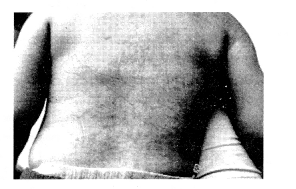
Answer:
Following are the characteristic features of dengue fever:
- Multiple rashes and wounds on the skin
- Loss of appetite
- Diarrhea and vomiting
- Gum and nose bleedings
- Severe joint and muscle pain
- Fatigue, nausea, and vomiting
- A sudden drop in blood pressure
- Pain behind the eyes coupled with extreme headaches (Any four)
Question 6.
The following beautiful picture shows an association between two types of organisms. Name the type of relationship and the organisms involved.
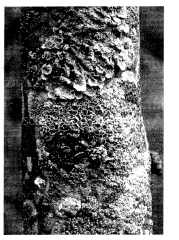
OR
How the two organisms involved in their association named as mycorrhizae benefitted by their association?
Also, name the type of relationship among the organisms. (2)
Answer:
This type of relationship is called as lichens. Lichens represent a mutual relationship between a fungus and photosynthesizing algae or cyanobacteria. The fungus helps in the absorption of nutrients and provides protection, whereas the algae, being photosynthetic prepares the food.
OR
The mycorrhiza is an association between fungi and roots of higher plants. Such a relationship is called as mutualism. In mycorrhizae, the fungi help the plant in the absorption of essential nutrients from the soil while the plant provides food for the fungi.
![]()
SECTION – B
(Section B has 6 Questions of 3 marks each.)
Question 7.
List any three industrial enzymes produced by microbes and their commercial uses. (3)
Answer:
The different enzymes produced by microbes and their uses is as follows:
| Enzyme | Uses |
| Lipases | Used in detergent formulations and are helpful. in removing oily stains from the laundry. |
| Pectinases and Proteases | Used for the clarification of bottled juices. |
| Enzyme | Uses |
| Streptokinase | It is used as a dot buster’ by removing dots from the blood vessels of patients who have undergone myocardial Infrction leading to heart attack. |
Question 8.
The given picture shows the binding of DNA probes to their complementary DNA. Probes are made complementary to the gene of interest so that they can bind and indicate the presence of the gene. Why the use of probes considered better than conventional diagnostic tools for disease diagnosis?
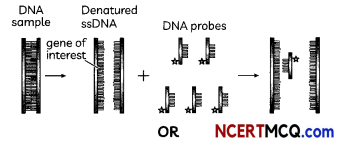
OR
The use of agrochemicals like pesticides and fertilizers has significantly increased the yield of crops. Still, it is suggested to make less use of such agrochemicals. Give any three disadvantages of using them. (3)
Answer:
Probes are considered to be better than conventional diagnostic tools because:
- Probes are highly specific and binds efficiently to the gene of interest. Using them is relatively rapid and much simpler method.
- Probes serve as a highly precise method as when combined with PCR especially, even a single molecule in the test sample can be detected.
- While using a probe, microbial culture is not required, so the risk of accidental infection to laboratory personnel is eliminated.
OR
The use of agrochemicals has many disadvantages such as:
- They cause environmental pollution.
- Heavy treatment of soil with agrochemicals can cause populations of beneficial soil microorganisms to decline.
- Highly dangerous to humans and animals in their concentrated forms.
![]()
Question 9.
Write any three features of animals that help them to survive in water-scarce environment. (3)
Answer:
Some features of animals which help them to survive in water-scarce environment are:
- No sweating/uricotelic/deposition of fat in subepidermal layer/burrowing nature/thick skin/ body covered with scales.
- Use of metabolically produced water.
- Mucous layer on the surface to reduce water loss by perspiration.
- Various hormones in humans like ADH help reduce water loss. (Any three)
Question 10.
Which two different categories of microbes are present naturally in sewage water? Describe their role in cleaning sewage water into usable water. (3)
Answer:
Bacteria and fungi are the two naturally occurring categories of microbes in sewage water. The bacteria from floes along with fungal mycelia and these floes are utilized during the secondary treatment of sewage.
After separation of the grit and debris, the primary effluent is taken for secondary treatment. The effluent is then passed to an aeration tank where it is agitated and air is pumped into it. As a result, this leads to vigorous growth of bacteria that consume the organic matter, thereby decreasing BOD of the sewage.
Question 11.
Nowadays it is said that we require another green revolution, due to the current food crisis.
What were the major limitations of the earlier green revolution? (3)
Answer:
The major limitations of the earlier green revolution were:
- The green revolution involved excessive use of fertilizers and pesticides which Led to pollution of the water bodies, soil, and food items.
- Lack of better management practices.
- Limited availability of improved crop varieties.
Question 12.
Broadly classify the extinction processes. (3)
Answer:
Classification of extinction processes:
- Natural extinction: It is due to a change in environmental conditions. It is at a very slow rate.
- Mass extinction: Mass extinction occurs due to catastrophes. In this case, a large number of species became extinct in millions of years.
- Anthropogenic extinction: The extinction of species is due to man’s activities. It is occurring in a short period of time.
SECTION – C
(Section C has a case-based question of 5 marks.)
Question 13.
The following picture shows the action of restriction enzymes on DNA. Based on the knowledge of rDNA technology answer the following questions
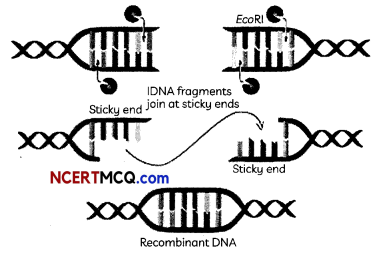
(A) Name the enzymes that are used to cleave both plasmid and the host DNA.
(B) In which year the first recombinant DNA molecule is synthesized?
(C) Expand ‘BAC’ and ‘YAC’.
(D) Who isolated and characterized the first restriction enzyme – Hindll and from which organism It was isolated?
OR
Advik was confused about the desirable properties of a cloning vector. His teacher explained him about the cloning vector with the help of the following picture. Based on the information answer the following questions:
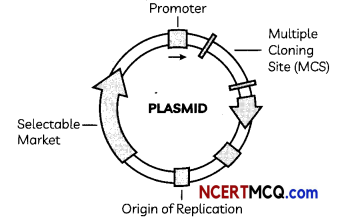
(A)
(i) Who discovered the cloning vector pBR322?
(ii) Which microorganism was used to manufacture genetically engineered insulin?
(iii) Name the vectors that are designed to replicate In the cells of two different species.
(B) What is the difference between clonIng vectors and expression vectors? (5)
Answer:
(A) Restriction endonucleases are the enzymes that are used to cleave both plasmid and the host DNA. These enzymes cleave DNA or cut phosphodiester bond at specific sites within the polynucleotide chain.
(B) The first recombinant DNA molecule was synthesized in the year 1972 by Paul Berg, Herbert Boyer, Annie Chang, and Stanley Cohen of Stanford University and the University of California, San Francisco.
(C) ‘BAC’ stands for Bacterial Artificial Chromosomes and ‘yAC’ stands for Yeast Artificial Chromosomes.
(D) The first restriction endonuclease-Hindi was isolated and characterized by Smith, Wilcox, and Ketley in 1968 from Haemophilus influenza.
OR
![]()
(A)
(i) pBR322 is a plasmid vector discovered by Rodriguez and Bolivar in 1977.
(ii) Escherichia coli (bacteria) was used to manufacture genetically engineered insulin.
(iii) The vectors that are designed to replicate in the cells of two different species are called as shuttle vectors.
(B)
| Cloning vector | Expression vector |
| They are the DNA molecules that can carry a foreign DNA segment into the host cell Example: plasmids, cosmids, etc. | The cloning vector containing suitable expression Signals to have maximum gene expression. The expression signals include insertion of a strong promoter and terminator, etc. |